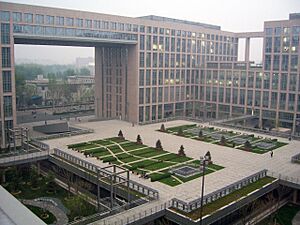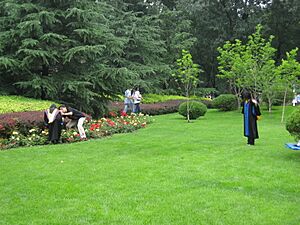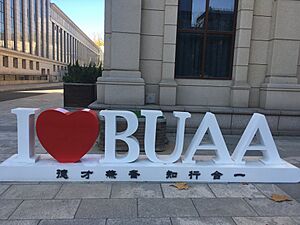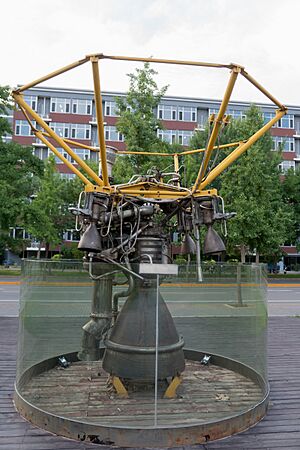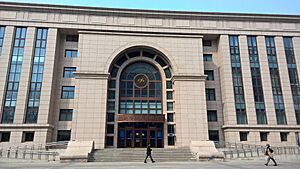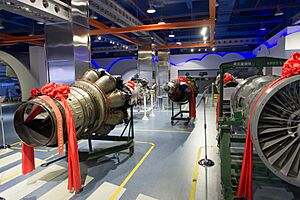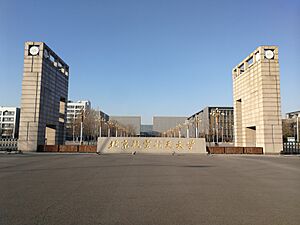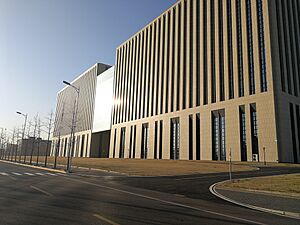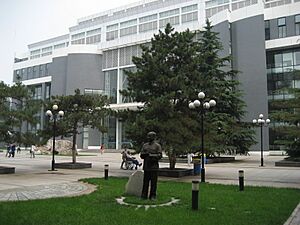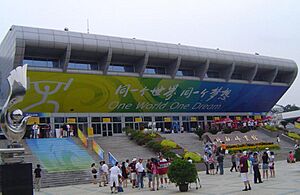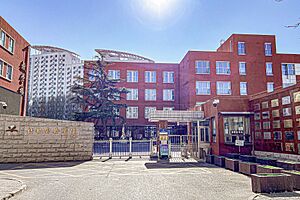Beihang University facts for kids
|
北京航空航天大学
|
|||||||
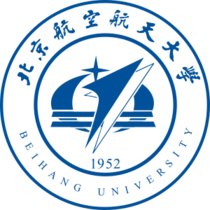 |
|||||||
|
Other name
|
BUAA Beihang |
||||||
|---|---|---|---|---|---|---|---|
|
Former name
|
Beijing University of Aeronautics and Astronautics | ||||||
| Motto | 德才兼备、知行合一 | ||||||
|
Motto in English
|
Integrate Virtue with Brilliance and Combine Knowledge with Practice | ||||||
| Type | Public research university | ||||||
| Established | October 25, 1952 | ||||||
| President | Wang Yunpeng (王云鹏) | ||||||
|
Academic staff
|
3,359 | ||||||
| Undergraduates | 12,523 | ||||||
| Postgraduates | 10,282 | ||||||
| Location | , | ||||||
| Campus | Xueyuan Road 100 hectares, Shahe 97 hectares | ||||||
| Colors | and | ||||||
| Affiliations | BHUA, SSU, TIME | ||||||
| Chinese name | |||||||
| Simplified Chinese | 北京航空航天大学 | ||||||
| Traditional Chinese | 北京航空航天大學 | ||||||
|
|||||||
| BCUR National | Domestic | 12 | |
|---|---|---|---|
| Wu Shulian National | Domestic | 21 | |
| CUAA National | Alumni | 17 | |
| QS National | General | 28 | |
| THE National | General | 21–25 | |
| QS Asia (Asia version) |
General | =134 | |
| THE Asia (Asia version) |
General | 49 | |
| ARWU World | Research | 151–200 | |
| QS World | General | =452 | |
| THE World | General | =168 | |
| USNWR World | General | =253 | |
Beihang University (also known as BUAA) is a famous public university in Beijing, China. It's especially known for its amazing work in aerospace engineering, which is about designing and building airplanes and spacecraft. In fact, some rankings say it's the best university in the world for this field!
The university is connected to the Ministry of Industry and Information Technology in China. It's also part of special national plans like Project 211, Project 985, and the Double First-Class Construction. These programs help make sure universities are top-notch and produce excellent research.
Beihang University was started in 1952. Back then, it was called Beijing Aeronautics College. It was formed by combining the aviation (airplane) departments from eight other important universities. In 1988, its name changed to Beijing University of Aeronautics and Astronautics. BUAA is also known as one of the "Seven Sons of National Defence" because of its important role in defense technology.
As a leading research university, Beihang has many special labs. It has 1 national laboratory and 9 national key laboratories. These labs help the university make amazing discoveries. Beihang has achieved over 40 "firsts" in China for its research. It has also won more than 70 top national science and technology awards.
Contents
History
Beihang University has been a very important national university since it started. It was the first place in China to offer higher education in aerospace. It's often called the "cradle of Red Aeronautical Engineers."
Beihang was one of the first national key universities in 1959. It was also among the first universities chosen for the "211 Project" in 1997. Later, in 2017, it became one of the first "world-class academic construction universities." This means it's recognized as a top university globally.
How it Started
Beihang University was created by bringing together aviation departments from eight different universities. These included famous schools like Tsinghua University and Xiamen University.
Before Beihang, China's aviation studies were not very strong. Even though the first Chinese airplane was built in 1909, the aviation industry didn't grow much. But after some difficult times, people in China realized how important aviation technology was. They started to believe in "air rescue of the nation." This idea meant that strong air power could help protect the country.
Many people traveled to other countries to learn about aviation. When they came back, they worked hard to set up aviation departments in universities. The first major in aeronautical engineering in China was started in 1934 at Chenghua University.
After the People's Republic of China was formed, the government decided to focus on the aviation industry. In 1951, they started to combine aviation departments from different universities. Premier Zhou Enlai, a very important leader, even said that "building an aviation university is urgent."
So, in May 1952, a plan was made to create a special aviation university. On October 24, 1952, the Beijing Institute of Aeronautical Industry was officially approved. This is what we now know as Beihang University.
Construction for the new campus began in June 1953 in Beijing. Workers built many buildings very quickly. By 1957, most of the main buildings were finished. In 1954, Wu Guang became the first president of Beihang University.
In 1958, Beihang students and teachers started a program to combine learning with hands-on work. They developed new aviation models. In just 100 days, they built the "Beijing No. 1" light passenger plane. This plane successfully flew between Beijing and Shanghai. They also developed "Beijing-2," which was Asia's first radiant missile. And they created "Beijing 5," China's first unmanned aircraft (drone). These achievements showed how innovative Beihang was. In 1959, Beihang became one of the first 16 key universities in China.
During the Cultural Revolution
During China's Cultural Revolution, teaching at universities was often stopped. Beihang University was also affected. However, because of its special focus on science and technology, it managed to continue some scientific research. For example, it produced unmanned reconnaissance aircraft during this time.
After the Cultural Revolution ended, normal university enrollment started again. In April 1988, the university's name officially changed to Beijing Aeronautics and Astronautics University.
The New Era
In 1989, Beihang University was chosen as one of the 14 key universities for China's "Eighth Five-Year Plan." This showed its growing importance.
In 1997, Beihang was included in the "211 Project," a national plan to boost key universities. Later, in 2001, it joined the "985 Project," which aimed to create world-class universities.
In 2006, the Beihang Art Museum was completed. The university also got permission to build the National Aeronautical Science and Technology Laboratory. A new main building for education and research was also finished. This new building is one of the largest educational buildings in Asia!
In 2007, the Shahe Campus of Beihang University started construction. It opened in September 2010. This new campus gave the university more space to grow.
Beihang University also played a role in the 2008 Summer Olympics in Beijing. Its stadium was used for the weightlifting events.
Since then, Beihang has continued to be a leader in education and research. It has joined other important national programs to train top engineers and promote innovation.
University Review
When Beihang University first started, it focused mainly on teaching and researching aviation. But over time, it has grown into a university that teaches many different subjects. These include science, engineering, liberal arts, law, economics, and more. However, engineering, especially aerospace, is still its main strength.
What Students Study and Who Teaches Them
Today, Beihang University has 30 different schools or departments. They cover 10 main areas of study. These include engineering, science, and management, with a special focus on aerospace.
As of 2017, Beihang has almost 4,000 teachers and staff. Many of them are top experts in their fields. This includes 23 members of China's national academies and 3 Nobel Prize winners!
The university has over 30,000 full-time students. This includes students studying for their first degree (undergraduates), master's degrees, and doctoral degrees. There are also many international students from other countries.
Labs and Research
Beihang University is home to many important research labs. In 2006, it was allowed to build the National Laboratory of Aviation Science and Technology. This lab officially opened in 2014 at the Shahe Campus.
The university also has 9 national key laboratories. These include labs for "Aeronautical Engine Aerodynamics," "Virtual Reality Technology," and "Computational Fluid Dynamics." These labs help scientists and students work on advanced projects and make new discoveries.
University Locations
Beihang University has several campuses and research institutes. Its main campuses are in Beijing.
Colleges and Schools
Beihang University has many different schools and colleges where students can study various subjects. Here's a list of some of them:
| Code | Academic Name | Found |
|---|---|---|
| 1 | School of Materials Science and Engineering (MSE) | 1954 |
| 2 | School of Electronics and Information Engineerin g(SEIE) | 1958 |
| 3 | School of Automation Science and Electrical Engineering (SASEE) | 1954 |
| 4 | School of Energy and Power Engineering (SEPE) | 1952 |
| 5 | School of Aeronautic Science and Engineering (ASE) | 1952 |
| 6 | School of Computer Science and Engineering (SCSE) | 1958 |
| 7 | School of Mechanical Engineering and Automation (ME) | 1952 |
| 8 | School of Economics and Management (SEM) | 1956 |
| 9 | School of Mathematics and Systems Science (SMSS) | 2009 |
| 10 | School of Biological Science and Medical Engineering (BME) | 2008 |
| 11 | School of Humanities and Social Sciences (HSS) | 1997 |
| 12 | School of Foreign Languages (SFL) | 1978 |
| 13 | School of Transportation Science and Engineering (TSE or TRANS) | 2007 |
| 14 | School of Reliability and Systems Engineering (RSE) | 1985 |
| 15 | School of Astronautics (SA) | 1988 |
| 16 | Flying College of Beihang University | 1993 |
| 17 | School of Instrumentation Science and Opto-electronics Engineering (SISOE) | 2003 |
| 18 | School of Beijing | 2013 |
| 19 | School of Physics and Nuclear Energy Engineering (SPNEE) | 2008 |
| 20 | The Law School of Beihang University | 2002 |
| 21 | School of Software | 2002 |
| 22 | School of Modern Distance Education | 2002 |
| 23 | Shen Yuan Honors College of Beihang University | 2002 |
| 24 | Beihang Sino-French Engineering School | 2004 |
| 25 | International School of Beihang University | 2004 |
| 26 | New Media Art and Design Institute | 2006 |
| 27 | School of Chemistry(SC) | 2008 |
| 28 | School of Marxism | 2008 |
| 29 | Institute for Advanced Studies in Humanities and Social Science | 2010 |
| 30 | School of Space and Environment (SSE) | 2016 |
| 35 | School of General Engineering (SGE) | 2017 |
| 37 | Beihang College | 2017 |
| 39 | School of Cyber Science and Technology | 2017 |
| 41 | School of Microelectronics | 2018 |
| 42 | Institute of Artificial Intelligence | 2018 |
| School of BeiDou and the Silk Road | 2017 | |
| International Research Institute for Multidisciplinary Science | 2012 | |
| Interdisciplinary Innovation Institute for Medicine and Engineering | 2016 |
Beijing Aerospace Museum
The Beijing Air and Space Museum is a cool museum located at Beihang University. It was opened in 1985 and was first called the Beijing Aviation Museum.
This museum has a large area for exhibits, about 8,300 square meters. It features 18 interactive exhibits, 3 theaters, and even a special education center for young astronauts! The museum's goal is to help people learn about aviation and space science.
The building itself is designed to look like a plane taking off, which is pretty neat! It shows how important aviation and space are to Beihang University.
Shahe Campus
The Shahe Campus of Beihang University is located outside the city center in Beijing. It's about 26 kilometers away from the main Xueyuan Road Campus.
This campus is very large, covering 970,000 square meters. It has many educational buildings, labs, student apartments, and even a stadium. It's a quieter campus with a nice environment. It opened in 2010 and is still growing. It's also easy to reach by subway.
Xueyuan Road Campus
This is the main campus of Beihang University, located in Beijing. It's divided into three parts: a teaching area, a living area for students, and a family area.
The teaching area is a pedestrian-only zone, meaning no cars are allowed. The student living area has 18 student apartment buildings. The modern buildings on the Xueyuan Road Campus are considered important architectural heritage from the 20th century in China.
Library
Beihang University has one of the best libraries in the world for books and information about aviation and space.
Other Research Institutes
Beihang University has also set up several research institutes in other cities in China. These include:
- Hangzhou Innovation Institute
- Qingdao Research Institute
- Qingdao Campus (under construction)
- Suzhou Innovation Research Institute (under construction)
- Chengdu Research Institute (under construction)
- Kunming Innovation Research Institute (under construction)
- Bihai College (an independent college)
These institutes help the university spread its research and education across different regions.
Beihang University Stadium
The Beihang University Stadium was an important venue during the 2008 Summer Olympics in Beijing. It hosted the weightlifting competitions.
Management
Who Manages Beihang?
Since it started, Beihang University has been managed by different government ministries related to the aerospace industry. Today, it's mainly connected to the Ministry of Industry and Information Technology of China.
The university also works closely with the Ministry of Education, the Chinese Academy of Engineering, and the Beijing Municipal Government. This shows how important Beihang is to the country.
Budget
Beihang University gets its money directly from the national government. This means it has a steady budget for its operations and research. In 2016, its science and technology budget was very high, showing how much the government invests in its research.
University Culture
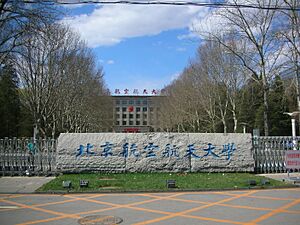
When the university first started in 1952, it was called "Beijing Institute of Aeronautics and Astronautics." People often called it "Beihang University" for short. In 1988, its official Chinese name changed to "Beijing University of Aeronautics and Astronautics." The English name was "Beijing Aeronautics and Astronautics University" (BUAA).
In 2002, the English name changed again to "Beihang University," but the abbreviation "BUAA" stayed the same. The beautiful Chinese name on the university's entrance gate was written by a famous calligrapher, Mr. Zhao Pochu, in 1988.
School Logo and Flag
The Beihang University logo has two circles, which represent the vastness of space and time. In the middle, there's a symbol that looks like an airplane flying upwards. This, along with an open book, a satellite orbit, and stars, shows that Beihang is all about aerospace and learning.
The year "1952" in the logo reminds everyone when the university was founded. The main color of the logo is "Blue Technology," which stands for being open, precise, stable, and brave in exploring new things.
The Beihang flag is blue with white letters or white with blue letters. It has the university logo and its name. Some Beihang flags have even traveled into space on Chinese spacecraft like Shenzhou 4 and Shenzhou 9!
School Song
Beihang University has an official school song called "Looking at the Stars." It was chosen in 2010. The lyrics were written by a former Premier, which is a very high-ranking government official.
School Spirit and Motto
The spirit of Beihang University encourages students to be:
- Hardworking and simple: This means being down-to-earth and letting actions speak louder than words.
- Hardworking and studious: This means loving science and always seeking the truth.
- All-round development: This means having good character, being smart, combining what you learn with what you do, and being serious in life.
- Brave in innovation: This means being brave to discover new things, always trying to improve, being a leader, and aiming for perfection.
The school motto is "Having political ability and integrity, integrating knowledge and practice." This means that everyone at Beihang should have good character, be honest, and have strong skills. It also means that they should not only learn theories but also put them into practice and use their knowledge to solve real problems.
School Anniversary
The anniversary of Beihang University is on October 25th every year. This is the day it was founded in 1952. Students often celebrate with a "campus anniversary carnival" on the weekend closest to this date.
Notable alumni
Beihang University has many famous graduates who have achieved great things.
Astronauts
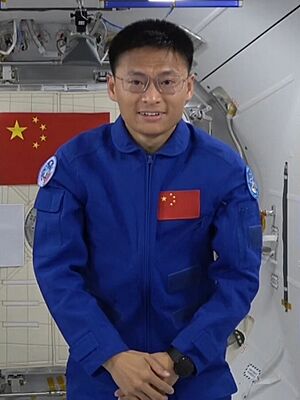
- Gui Haichao: A Chinese academic and astronaut who has traveled to the Tiangong Space Station.
Engineers
- Qi Faren: The chief engineer for the Shenzhou program, which is China's human spaceflight program.
Politicians
- Zhu Fenglian: A spokesperson for the Taiwan Affairs Office.
- Yuan Jiajun: A high-ranking member of the Communist Party of China, and a former chief of the Shenzhou program.
- Li Peiyao: A former vice chairman of an important political conference.
- Zhang Guoguang: A former governor of two Chinese provinces.
The Military
- Yang Dongming: A lieutenant general and former deputy commander of the PLA Air Force.
Financier
- Jiang Bin: A billionaire who helped start the company GoerTek.
Writer
- Xue Yiwei: A Chinese writer.
Aircraft projects
Beihang University has been involved in developing several aircraft projects, including:
- Beijing 1
- BUAA Mifeng-6
See also
 In Spanish: Universidad de Beihang para niños
In Spanish: Universidad de Beihang para niños
- Beijing Air and Space Museum


